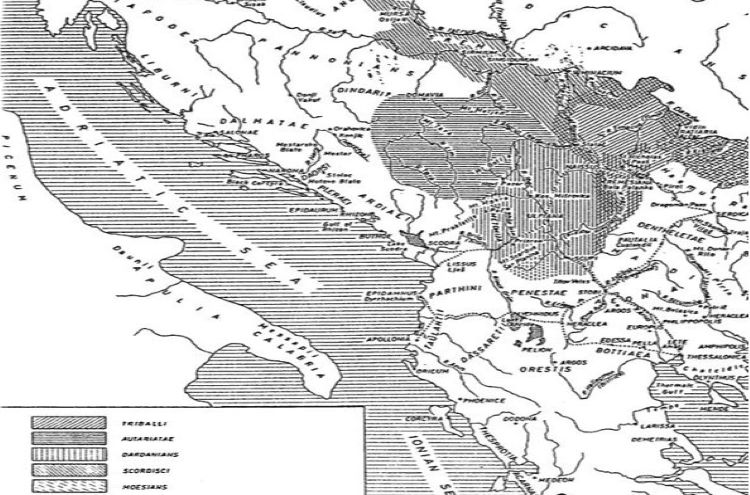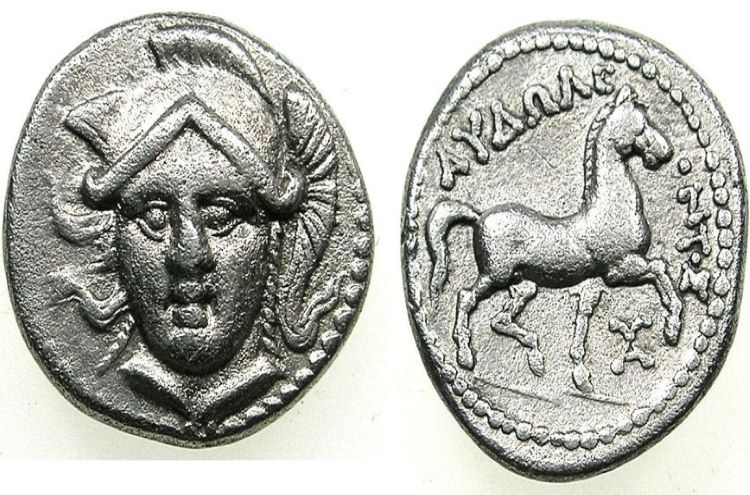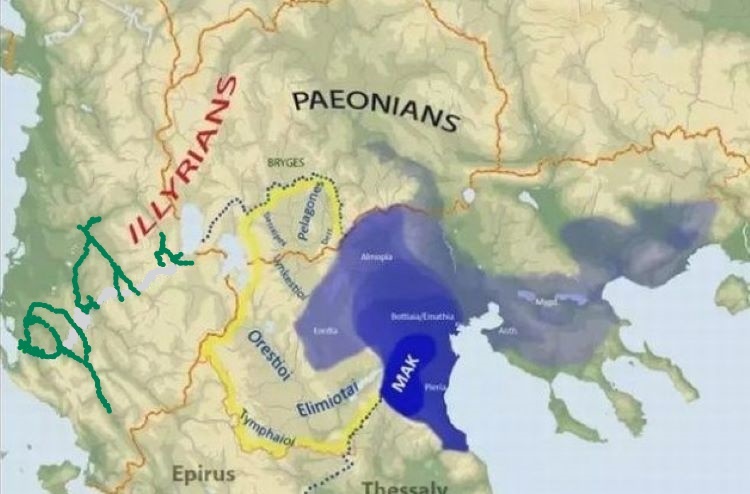
Audoleon: The Wealthiest King of Paeonia
Audoleon was king of the kingdom of Paeonia during the late IV-early III century B.C.E. He remains the most renowned king of Paeonia despite the lack of sources to solidly back up this claim.
Audoleon’s early reign
Audoleon succeeded his father Patraus to the throne of the Paeonian kingdom in about 310 B.C.E. Diodorus reports that this year Audoleon was busy fighting the Autariatae, an Illyrian tribe to his north. If we believe Justin, this was a large incursion of the Autariatae who fled from their home after an infestation of frogs and mice. They eventually overran the kingdom of Paeonia where Audoleon had just assumed the kingship. Audoleon resolved the issue through Cassander, then the effective ruler of Macedon to his south. Accordingly, Cassander interfered in Audoleon’s favor and settled the twenty thousand Autariatae far from the Paeonian kingdom, into Mount Orbelos (modern mount Lekani).

From Cassander’s intervention in Paeonia, we may infer that Audoleon was on good terms with his southern neighbor. However, the details of his rule fall into obscurity in the literal evidence. What we know about this king in this time comes from numismatics and indirect events. We know that Audoleon struck silver tetradrachms in his early years as ruler. These coins had the same weight standard as those issued by his predecessors, Lycceios and Patraus. Later, Audoleon issued another type of tetradrachm; apart from the change in iconography these new coins bear the legend “of king Audoleon”. The legend itself is enough to conclude that Audoleon followed the example of the other Diadochi (Successors) who, after 306, proclaimed themselves kings. With these issues, Audoleon proclaimed Paeonia as an independent kingdom with him as king.
A Basileus in the Shadows
In the following years, the fight for Alexander’s imperial remnants take the center stage as Paeonia slips into the background. Antigonus’ hopes for a great empire of his own are crushed by the other contenders at the Battle of the Ipsus (301). Antigonus’ son, Demetrius continued in his father’s footsteps and turned Europe into his theatre of war. The Besieger found a great contender in Pyrrhus of Epirus who felt worthy as anyone else to rule Macedon. To counter the threat of Demetrius, in 292 Pyrrhus took off on a policy of establishing regional alliances; marriage being the political tool for sealing these alliances. Thus, the Epirote king married the daughter of the Illyrian ruler Bardylis (II) and a daughter of Audoleon himself. Audoleon’s involvement/participation in this alliance means that he shared similar hostile views against Demetrius as Pyrrhus did during this time.

During the winter of 287/286 the main enemies of Demetrius, Pyrrhus, Lysimachus, and Ptolemy, attacked him at once. Demetrius had to abandon Macedon which was divided between Pyrrhus of Epirus and Lysimachus. Demetrius ultimately lost his cause in Asia but a garrison of him still retained control of Piraeus. Demetrius’ son, Antigonus II Gonatas, had no intention of relieving Piraeus and other small regional fortresses he now commanded. This placed Athens in a difficult situation where the city could not provide adequate food supplies; it had to rely on allied help to get through the famine.
Ally & Benefactor of Athens
One of such allies, who helped Athens in this desperate time, was Audoleon himself. An Athenian inscription honors king Audoleon for his help in supplying the city with food. According to the inscription, Audoleon had gifted the city 6,500 medimnoi of grain (about 336.9 tonnes). His aid followed similar previous aids provided to Athens by a Ptolemaic officer and then by Spartacus III, king of Cimmerian Bosporus. The participation of Audoleon in helping Athens is solid proof of his participation in the anti-Antigonid coalition along with his son-in-law Pyrrhus and Lysimachus. It’s also a testimony to the considerable wealth the Paeonian kingdom enjoyed during the reign of Audoleon. As for the inscription IG II3 1 871 which honored Audoleon with Athenian citizenship, here is the translated text in full:

The Attic inscription
“In the archonship of Diotimos (285/4), in the twelfth prytany, of Pandionis, for which Lysistratos son of Aristomachos of Paiania was secretary. On the twenty-fifth of Skirophorion, the twenty-fifth of the prytany. Assembly. Of the presiding committee Philomelos son of Philomelos of Halai was putting to the vote and his fellow presiding committee members. The People decided. Simonides son of Hegemon of Hagnous proposed: since Audoleon king of the Paionians both from earlier times has been of good will to the Athenian People, being of service and joining the effort for the freedom of the city, and when the People delivered the town, on learning this he was delighted at the success that had occurred, considering that the preservation of the city was as one with his own, and he is of service both individually to Athenians spending time with him and those arriving in the country; and he has given a gift of grain to the People of 7500 medimnoi from Macedonia at his own expense, having delivered it to the 30 harbours of the city; and further he announces that in the future he will be of service by joining the effort for the deliverance of the Piraeus and the freedom of the city, for good fortune, the People shall decide: to praise king Audoleon son of Patraos of Paionia for his excellence and good will for the Athenian People and to crown him with a gold crown, and to announce the crown at the tragedy competition of the Great Dionysia; and the board of administrators shall manage the making of the crown and the announcement; and he shall be Athenian, and his descendants, and it shall be possible for him to enrol in the tribe and deme and phratry that he wishes; and the prytany that is allotted to preside next shall put the vote about him at the next Assembly, and the court presidents shall bring for him the scrutiny of the award to the court whenever it is possible; and they shall stand a bronze statue of him on a horse in the Agora; and the board of administrators shall manage the making and the setting up. . .” (IG II3 1 871).
The Mystery of Audoleon’s Treasure
The Attic inscription is the last reference we have on Audoleon while he is still alive. Next, we hear from Polyaenus how Lysimachus deceived Ariston, Audoleon’s son, and successor. The satrap of Thrace drove Ariston out of Paeonia and took the country under his possession. Since Lysimachus was himself soon killed at Corupedium, we can confidently place the end of Audoleon’s reign in between 284 and 282.

We can learn more about the circumstances of Audoleon’s legacy by a rare source, a passage of Tzetzes attributed to Diodorus (Tzetzes, Hist. VI. LIII. (470-480) = Diod. XXI. 13.). According to this passage, Audoleon tried to hide his treasure before his demise. He entrusted the task to his closest friend, a certain Xermodigestos. The latter used captives to divert the course of the Sargentinos river and buried the treasure there. Then, he ordered the river to flow again into its original course so that the flow would conceal the hiding place; also all the captives that worked in the matter were killed. When Lysimachus intervened, Xermodigestos was the only one who knew the location of the treasure; he revealed it to Lysimachus. This revelation ends all the tangible legacy left by Audoleon.
Conclusion
It’s unknown how accurate is the passage of Tzetzes as there are just doubts about its truthfulness or correctness. In any case, it’s quite a metaphor in depicting the spiraling down of Paeonia after the rule of Audoleon. It’s clear that, despite the considerable lack of literal evidence, Audoleon was possibly the greatest ruler Paeonia ever had. The words of Merker do to Audoleon’s figure further justice: “It is a pity that we know so little about him, for he must have really been a remarkable man. As long as he lived, he managed with the support of his rather small and backward kingdom to maintain his position in an age of really stupendous change, among the extremely able successors of Alexander the Great”. (Irwin L. Merker, The Ancient Kingdom of Paionia).
Bibliography
IGII31 871. Citizenship for king Audoleon. Source: https://www.atticinscriptions.com/inscription/IGII31/871.
Merker, I. L. (1964). The Ancient Kingdom of Paionia. Rutgers, The State University.
Pavlovska, E. (2012). A Coin Hoard of the Paeonian king Lycceius. Skopje.
The Eastern Celts – Coins Derived from Philip II of Macedon Tetradrachms. Collecting Ancient Coins. Accessed on: https://collectingancientcoins.co.uk/the-eastern-celts-coins-derived-from-philip-ii-of-macedon-tetradrachms/.








